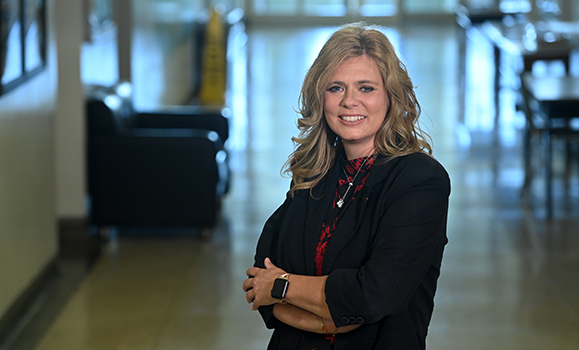Dalhousie has changed a lot since Sonia Beattie was an undergraduate psychology student at the university in the 1990s. There are more students, more campuses and buildings, more Faculties, more programs â more of everything, really.
This growth, fuelled by years of hard work and planning, has brought added vibrancy to the university but also more complexity in how it is run. Dal's planning and analytics team, led by a vice-provost, helps keep the university's many gears oiled by providing integrated university-wide planning processes, project management, and guidance and access to high-quality institutional data, analysis, and advice to ensure informed decision-making.Â
 When Beattie returned to Dal as the university's new vice-provost of planning and analytics in June, she got an up-close glimpse into these many processes and a mandate to help support and unlock the promise of an even bigger and better Dalhousie for tomorrow.
When Beattie returned to Dal as the university's new vice-provost of planning and analytics in June, she got an up-close glimpse into these many processes and a mandate to help support and unlock the promise of an even bigger and better Dalhousie for tomorrow.
âIâm really thrilled to be back on campus at Dal at what I see as an exciting time for the university full of opportunities,â she says.
Beattie's path to Dal wasnât exactly straightforward. She spent time early in her career in the private sector and did a stint in health care, too. But she consistently kept returning to higher-ed, taking on leadership roles at Acadia University and completing a Masterâs in education from Memorial University of Newfoundland remotely as well. Â
âEducation was really my passion. From the time I was young and early in my career, I knew that I wanted to work in the postsecondary sector with my goal focused on senior leadership,â she says.
Beattie joined Dal this year from the Nova Scotia Community College after a 13-year stretch there serving in various leadership positions, including head of institutional research, academic chair of the School of Business, and, most recently, director of academic operations and planning.
In her new role, Beattie serves on the leading edge of Dalâs work to advance institutional planning and analytics work at the university through several high-profile initiatives. Below, we chat with Beattie about some of these projects and broader considerations such as bringing the universityâs latest Strategic Plan (2021-2026), Third Century Promise, to life.
pilipiliÂþŧ is a large, complex organization, meaning there a lot of areas that would benefit from planning and a lot of potential data to collect and assess. How do we decide what to prioritize?
pilipiliÂþŧ is indeed a big organization, but one that is committed to working together to support student pilipiliÂþŧ and ensuring that the university continues to be recognized as a leader in teaching, learning and research excellence. The introduction of Dal's strategic plan, Third Century Promise, last year has really helped ensure that we are all moving in the same direction towards common goals and objectives in supporting the academic mission of the institution.
All our work centres around putting the experience of our students, staff and faculty at the forefront. We have access to a vast amount of information and are collaborating with departments to use that data to inform our decision making through the planning process. Doing the research and understanding the data can really ensure that we are making the best decisions that will support the mission of the university and also give us the highest chance of pilipiliÂþŧ in supporting our teaching, learning and research objectives.
Universities have changed a lot in recent decades and so has university administration. For example, the idea of having an office for Planning and Analytics still seems relatively novel. Why does your role and department exist now when it might not have 20 years ago?
Institutions that have a culture of strategic planning tend to do a better job of adapting to changing conditions, while also ensuring that they are meeting the key outcomes and objectives set forth in their missions and strategies. Institutions are also beginning to realize the value of the vast amount of information at their fingertips in informing decision making.
The establishment of a department like Planning and Analytics helps a university of Dalâs size to connect the dots to support the goals laid out in its strategic plan. Through integrated planning, Dal's community can set strategic priorities for the university together and support a more coordinated approach to resources. Our department creates space for collaborative integrated planning, using data to inform decision making and ensure that our resources align with the work of the university to ensure a quality working, teaching, learning and research experience for our students, faculty, and staff.

Related reading: A new vision for the student experience â Get to know Rick Ezekiel, Dal's new vice-provost, student affairs
How can universities use data to understand the student experience and ensure we are providing an environment where they feel supported and pilipiliÂþŧful?
We know that the post-secondary landscape is increasingly competitive and constantly changing, with students having many options and choices. At Dal, we are strongly committed to providing an exceptional and equitable experience for those students who choose to come here. Their pilipiliÂþŧ is a reflection of the great work of the university, and we want to continually strive to create an exceptional experience for them.
Through data, we are able to identify trends and opportunities to support not only the development of new initiatives to support our goals but how well we are meeting them as well. Â We can better understand the needs of our students and how to use data to plan how we can support students. There is so much information that is at our fingertips that can provide insight into the student experience, and itâs our job to help determine the types of initiatives and opportunities we can offer to enhance the experience of our students as they come to Dalhousie.
One of the key projects your office leads at the university is the Digital Strategy, a comprehensive plan for Dalâs digital infrastructure that supports excellence in teaching, learning, research, the student experience, and administrative functions at Dal. Why is a strategy like this so important to Dalhousie?
The Digital Strategy supports decisions and governance around what technology Dal needs to support education and research and to thrive in a digital environment. It is a strategic imperative for the university and provides a framework to transform Dalhousie's digital infrastructure with a people-centered focus on how we support teaching, learning, research, and the student experience.
It will enable our pilipiliÂþŧ in the initiatives set out in our strategic plan and help to maximize the benefits of data assets and technology-focused initiatives. The strategy will also ensure that we will have a barrier free, seamless experience for our students, faculty, and staff with appropriate systems, policies, and technologies in place to ensure that every member of the Dal community has the tools they need to do their studies, research, and work.
Further reading:Â Bringing Dal's Third Century Promise to life: âAn expression of our collective ambitionâ

